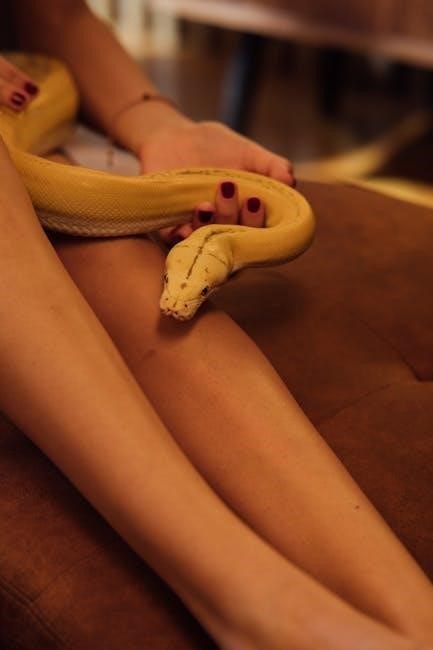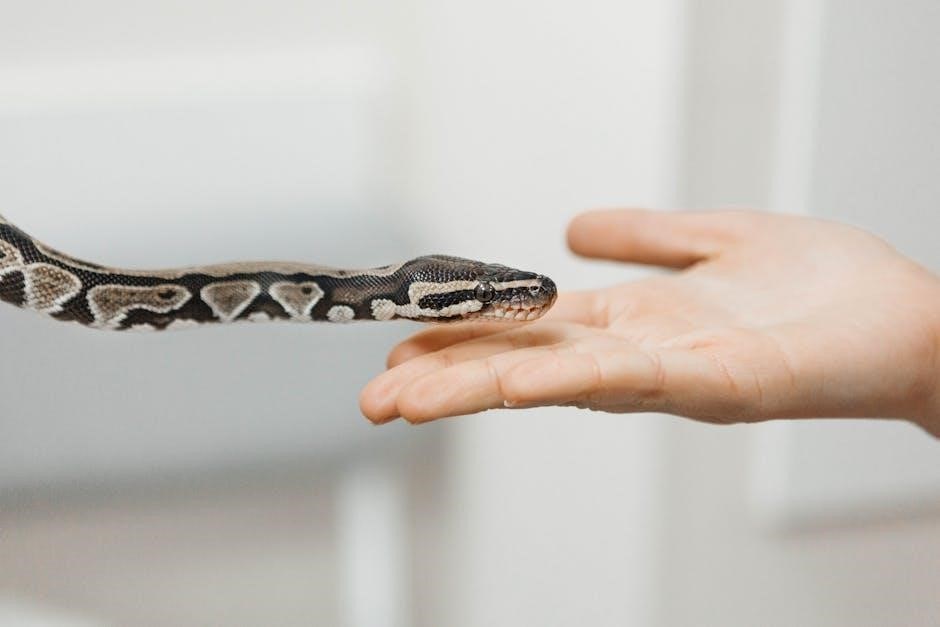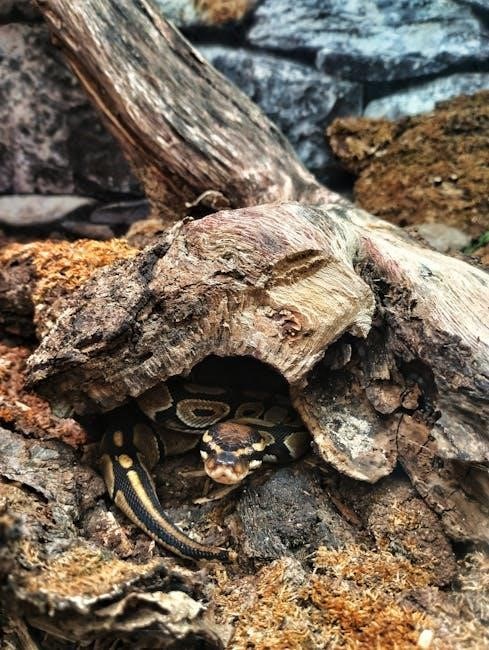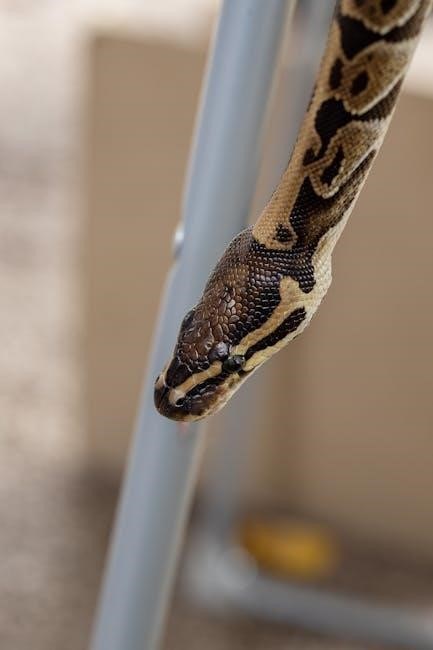guide to ball python morphs

Ball Python morphs are unique genetic variations that create distinct color and pattern traits. These variations have captivated breeders and enthusiasts, driving advancements in reptile genetics and breeding techniques.
Morphs are inherited traits that alter appearance, making each snake visually striking. This diversity has made Ball Pythons popular pets, with over 4,000 recognized morphs available today.
The study of morphs is essential for understanding genetic principles and their role in creating these stunning variations, making Ball Pythons a focal point in reptile breeding and ownership.
1.1 What Are Ball Python Morphs?
Ball Python morphs are genetic variations that result in unique color and pattern traits. These inherited characteristics create distinct appearances, such as albino, banana, or leucistic patterns. Morphs are not separate species but variations within the same species, making each snake visually unique. They are achieved through selective breeding, emphasizing specific genetic traits to produce stunning and diverse outcomes.
1.2 Importance of Morphs in the Hobby
Ball Python morphs have revolutionized the reptile hobby by offering incredible diversity in color and pattern. They attract enthusiasts, breeders, and pet owners, fostering a vibrant community. Morphs drive innovation in breeding, pushing genetic boundaries and creating unique traits. Their popularity also influences market demand, with rare morphs commanding higher prices. This diversity enhances the hobby’s appeal, making Ball Pythons one of the most sought-after pet snakes worldwide.

Popular Ball Python Morphs
Popular Ball Python morphs include Albino, Banana, and Blue Eyed Leucistic, each offering unique color patterns and traits. These morphs are highly sought after for their striking appearances.
2.1 Albino Ball Python
The Albino Ball Python lacks melanin, resulting in a striking yellow and white pattern with red eyes. This morph is highly popular due to its unique appearance and genetic significance in breeding programs. Albino Ball Pythons are among the most recognizable and sought-after morphs, making them a favorite among collectors and enthusiasts alike. Their genetic traits have played a crucial role in the development of other morphs through selective breeding.
2.2 Banana Ball Python

The Banana Ball Python is a striking morph known for its vibrant yellow blotches and dark freckles on a light background. This unique pattern has captivated breeders and enthusiasts, making it one of the most well-known morphs. Its distinctive appearance and genetic traits have made it a popular choice for those looking to add a visually appealing snake to their collection or breeding program.
2.3 Blue Eyed Leucistic Ball Python
The Blue Eyed Leucistic Ball Python is a rare and visually stunning morph. It features a pale, almost white base color with subtle markings and striking blue eyes, a result of leucism reducing pigmentation. This unique appearance makes it highly sought after by collectors and breeders, adding to its allure in the reptile community.

Rare and Exotic Ball Python Morphs
Rare and exotic Ball Python morphs showcase unique genetic combinations, offering extraordinary colors and patterns. These morphs, often resulting from selective breeding, are highly prized for their distinctiveness and beauty.

3.1 Pastel Ball Python
The Pastel Ball Python is a rare and stunning morph known for its soft, pastel-like coloration. It features delicate hues of pink, lavender, and champagne, creating a visually striking appearance. This morph is highly sought after by collectors and breeders due to its unique beauty and limited availability. Its genetic traits make it a standout in the world of Ball Python morphs.
3.2 Spider Ball Python
The Spider Ball Python is a rare and exotic morph characterized by its unique, web-like pattern. It features irregular, fragmented markings that give it a “spider web” appearance. This morph is a result of a recessive genetic trait and is highly prized for its striking visual appeal. Spider Ball Pythons are challenging to breed, making them highly sought after by experienced enthusiasts and collectors.
Ball Python Morph Genetics
Ball Python morph genetics involve inherited traits that determine color and pattern variations. These traits are shaped by recessive and dominant genes, influencing the snake’s appearance and uniqueness;

4.1 Genetic Basics for Breeders
Understanding genetic basics is crucial for Ball Python breeders. Morphs are determined by specific genes, with traits like albinism or leucism resulting from recessive alleles. Breeders must grasp dominance and recessiveness, as well as how genes combine to create distinct patterns and colors. This knowledge enables intentional breeding to achieve desired morph traits, enhancing both diversity and uniqueness in offspring.
4.2 Role of Genetics in Morph Development
Genetics play a pivotal role in the development of Ball Python morphs, as specific genes dictate color and pattern variations. Mutations in genes can suppress or enhance pigmentation, leading to unique traits like Piebald or Axanthic. These genetic factors interact to create diverse morphs, showcasing the complexity of hereditary influences.
Understanding how genes combine is essential for predicting offspring traits, enabling breeders to selectively produce desired morphs and expand the genetic diversity of Ball Pythons.

Pricing and Availability of Ball Python Morphs
Pricing varies based on morph rarity, demand, and genetic complexity, with common morphs like Albino costing $300–$500, while rare morphs can exceed $1,000, reflecting their exclusivity and genetic uniqueness.
5.1 Factors Influencing the Cost
The cost of Ball Python morphs is influenced by rarity, genetic complexity, breeder reputation, and market demand. Rare morphs like Blue Eyed Leucistic are more expensive due to their unique genetics. Breeders with a reputation for high-quality snakes often charge premium prices. Additionally, seasonal demand and the availability of specific morphs can fluctuate, impacting their pricing. These factors combine to determine the final cost of a Ball Python morph.

5.2 Price Range for Different Morphs
Ball Python morph prices vary widely, from $100 for common morphs like Normal or Albino to $10,000+ for rare genetic combinations. Morphs like Pastel or Banana typically range between $300 and $1,000, while Blue Eyed Leucistic can cost $1,000 to $3,000. Rare morphs, such as Piebald or Axanthic, often exceed $2,000. The diversity in pricing reflects the genetic uniqueness and demand for specific traits, making each morph an exciting investment for enthusiasts.
History of Ball Python Morphs
Ball Python morphs originated from unique genetic traits observed in African wild-caught snakes during the 1990s. Early discoveries led to selective breeding, creating iconic morphs like Albino and Hypo.
6.1 Early Morphs and Their Origins
The first Ball Python morphs emerged from African imports in the 1990s, with unique traits like albinism and unusual patterns sparking interest. Breeders began isolating these traits, leading to the development of foundational morphs such as Albino, Hypo, and Piebald. These early discoveries laid the groundwork for the diverse morphs seen today, revolutionizing the hobby and inspiring further genetic exploration.
6.2 Evolution of Morph Breeding
Over decades, Ball Python morph breeding has advanced significantly, shifting from simple trait isolation to complex genetic combinations. Early morphs like Albino and Hypo laid the groundwork, while modern techniques now combine multiple traits to create stunning variations. The rise of genetic knowledge and selective breeding practices has enabled the development of intricate morphs such as Super Pastel and Mystic, continually expanding the diversity of Ball Python morphs available today.

Morph-Specific Care and Maintenance
While most Ball Python morphs share similar care requirements, some may have specific needs. Habitat, diet, and health checks should be tailored to the morph’s unique traits.
7.1 Care Requirements for Different Morphs
Ball Python morphs generally thrive under similar conditions, but specific morphs may require tailored care. Ensure proper habitat setup, including a temperature gradient and adequate humidity levels.
Feeding needs remain consistent across morphs, but monitor individual preferences. Provide pre-killed prey of appropriate size and maintain a clean, stress-free environment.
Regular health checks are crucial, as some morphs may be prone to certain issues. Consult a veterinarian experienced in reptiles to address morph-specific health concerns promptly.
7.2 Health Considerations
While Ball Python morphs are generally hardy, certain morphs may have specific health considerations. For example, Albino and Leucistic morphs can be more prone to respiratory issues due to genetic factors. Regular health checks and a clean environment are essential to prevent common ailments like mites or metabolic bone disease. Ensuring proper care and nutrition helps maintain optimal health across all morphs.
- Monitor for signs of respiratory distress or skin issues.
- Provide a stress-free habitat to prevent health complications.
- Consult a reptile-savvy veterinarian for morph-specific health advice.

Breeding Ball Python Morphs
Breeding Ball Python morphs is an intricate process involving genetic selection and pairing to achieve desired traits, requiring expertise in herpetology and genetics.
8.1 Basics of Breeding for Morphs
Breeding Ball Python morphs starts with understanding genetic principles and selecting snakes with desired traits. Breeders must pair snakes strategically to produce specific combinations of color and pattern;
Proper housing, nutrition, and health care are crucial for successful breeding. Seasonal breeding cycles and controlled environments optimize reproduction, ensuring healthy offspring with the intended morph characteristics.
8.2 Challenges in Morph Breeding
Breeding Ball Python morphs presents challenges, including genetic unpredictability and health risks. Certain morphs may carry recessive traits that can lead to unforeseen issues in offspring, requiring careful selection and testing.
Additionally, achieving specific morph combinations demands precision, patience, and significant resources. Health monitoring and controlled breeding environments are essential to mitigate risks and ensure successful outcomes in morph breeding efforts.
Ball Python morphs have revolutionized the reptile hobby, offering incredible diversity and beauty. Their growing popularity promises exciting future developments in genetics and breeding.
9.1 The Growing Popularity of Morphs
The popularity of Ball Python morphs has soared due to their stunning diversity and unique traits. With over 4,000 recognized morphs, enthusiasts are drawn to their vibrant colors and patterns. This surge in demand has fueled advancements in breeding techniques, making rare and exotic morphs more accessible. As a result, Ball Pythons remain a favorite among reptile hobbyists and breeders alike.
9.2 Future Trends in Ball Python Morphs
Future trends in Ball Python morphs will likely focus on genetic advancements, leading to even more unique and complex patterns. As genetic research evolves, new and rare morphs will emerge, captivating enthusiasts. The growing popularity of exotic traits will drive breeders to experiment further, ensuring the hobby remains dynamic and innovative for years to come.




